The Most Important Key to Supporting Struggling Writers
Inside this post: No matter the age, if you’re supporting struggling writers, there’s one key ingredient that is a game changer for building confidence and increasing achievement.
During a writing unit, teachers are often met with groans, blank stares, and sudden requests for trips to the bathroom, nurse’s office, or the moon (pretty much anywhere but the classroom)… like, right now.
Students can struggle with writing for a variety of reasons: writer’s block, lack of ideas, disorganization, or disconnection. Specifically, in this post, we’re talking about writers who, skill-wise, aren’t quite ready for grade-level expectations.
Recently, I chatted with a teacher I connected with through my blog.
Jen reached out through email, and I asked permission to share her experience because I think it speaks to many of us. Jen had just finished some amazing lessons on introduction paragraphs, and, full of hope, she collected her students’ first drafts.
I just collected my students’ paragraphs and they are ALL.OVER.THE.PLACE!!!!! UGH! I just don’t know what to do. Any guidance on extra help in this area? They are especially struggling with writing a bridge. I just can’t quite get it across to them what they need to be doing.
You can hear it in her tone: desperation, the kind that compels you to read every page of the internet before grading those essays. We can all relate to this frazzle.
Here’s the Problem
Supporting struggling writers is somewhat similar to attending professional development sessions.
Every January, I attend a huge reading conference. Presenters talk about everything from teacher leadership to instructional strategies and from interactive read alouds to tracking growth with reading achievement.
This January, like all the others, I sat in my seat, fidgeting. Literally, the ideas were so good that I just wanted to start implementing them….now. The excitement nearly gave me cold sweats.
The problem with conferences, and especially multi-day events, is that by the end of the whirlwind PD, you’re often on overload.
- Excitement turns to realization that you’re not sure where to begin implementing all of the good ideas.
- And, that reality can turn into overwhelm.
The thing is, many adults don’t allow that feeling of overwhelm to take root. We take a couple of days to go back to our classrooms, flip through our notes intermittently, and chat with others about what we learned. Then, slowly, we begin implementing the ideas we think will help our students the most.
Young writers, and many students who already lack confidence with their writing abilities, do not have that same ability to process large amounts of information in short sittings. They can and sometimes do get overwhelmed.
So, while we may have purchased or created the best resource possible, there’s still a key ingredient missing from our writing instruction.
The Best Solution
Think about the best instruction you’ve ever experienced. Mr. Briggs was my favorite English teacher in high school (the one who inspired me to teach ELA!).
I was scared to death to read Macbeth. As a teen, it might as well have been a foreign language. Several key elements of his instruction during that unit built my confidence, leaving me feeling like I could conquer the most complex text assigned.
- We read it together.
- He modeled how to break down the language…showing us his internal thought process as we read.
- The teacher talked with us, one-on-one, and in groups, about our understanding.
- He didn’t ask us to read it at home, by ourselves. He just knew we weren’t ready for that.
As I thought back on all of the ways Mr. Briggs made that unit (and so many others!) challenging yet attainable for us, I realized the key to effectively supporting struggling writers is actually in slowing down.
While our curriculum maps and pacing guides may pressure us to sprint through each unit as if a wild boar were right on our heels, we have to step back and truly ask ourselves what students take away from that experience.
Are we helping them understand themselves as writers? really making sure they are proficient with standards? building their confidence?
After working with 7th graders through seniors and Title I through honors students for years, I can say that this ingredient works. Students are more confident. Overwhelm and stress don’t play as big of a roll in the learning process. Plus, the final product is higher quality.
7 Powerful Strategies for Supporting Struggling Writers
So, back to Jen. When I emailed her a response, I suggested she implement the secret ingredient to teaching writing. But, what exactly does it mean to slow down?
It’s not giving students five days to write a paragraph or spending extra minutes on a slideshow presentation. Instead, we can think about slowing down in terms of opening up opportunities for incorporating a variety of effective instructional strategies.
Like….
1. Chunking lessons
How small of chunks students need really depends upon your group. Personally, I only assign one paragraph at a time. That way, students can take my feedback and apply it to the rest of the paper. If you teach too much, you’ll know! Students won’t apply the skills, will shut down, or will turn in a hot mess.
2. Writing with students
All of my students have absolutely LOVED it when we write together! Whether you have a white board, a chalkboard, or a smart board, make sure to take time to write together. I offer this shared writing experience after direct instruction about the paragraph type and after analyzing good examples.
3. Reteaching
As you read students’ drafts, make notes of common areas of confusion. For example, maybe many students are not elaborating on research well, or maybe the conclusion paragraphs are more of a summary than a synthesis.
Give a review mini lesson on each element. Create examples of common areas for growth (look at what your students are doing and mimic it). Then, model how you would revise using think alouds.
4. Simplifying
Instead of trying to teach students ten different hooks, 3 different thesis statement formats, and 8 ways to end an essay, reduce the overwhelm. Give them a couple options that are grade appropriate and that push them just enough outside of their comfort zone…but not to the frustration point.
If your students are currently beginning their essays with something like, “Hello, my name is…” or “Did you know…?” they will probably not be ready to take on the same type of hook as the student who is using a statistic or quotation. Supporting struggling writers means simplifying and differentiating.
5. Conferring
One of the most important ways we can give students feedback on their writing is to confer with them. Meeting with students individually in middle and high school presents unique challenges due to shortened class periods, but we can make it quicker!
- Sit with students as they work, get a feel for how they are doing, and just offer one suggestion.
- Have students come to the conference prepared to ask for help with the issue that confuses them most.
- Prompt students to highlight or annotate the changes they made after revising their paragraph.
6. Revising
Give writers time and encouragement to revise after receiving feedback. It’s one of the most powerful ways for them to truly build new skills.
7. Connecting
Take time to show students the connection between reading and writing. Encourage them to dig into mentor texts. What is the author’s style, and how did they develop it? How could your students utilize some of those same stylistic choices in their own writing to impact flow, meaning, or tone?
And, I heard back from Jen not too long ago.
The writing it SO.MUCH.BETTER! Thanks so much for your help. I broke it all down again. On Tuesday, I used another practice that helped them see a lot more hooks and how they properly connect to the claim. Then I showed some exemplar introductions highlighted the claim, then added the hook, and then we bridged it together as a whole group (modeling was key!).
While incorporating these effective teaching strategies might result in adding days to our writing units, whether or not those days increase achievement really does depend on what we use that time to do. When we slow down, we have time to provide the kind of effective instruction and meaningful feedback struggling writers need to thrive.
READ NEXT:
- Scaffolding the 5 Paragraph Essay
- 14 Ways to Support Struggling Writers
- The Big List of Ways to Motivate Reluctant Writers
RELATED RESOURCES:
Scaffold and chunk writing experiences for students in order to reduce overwhelm and increase confidence. These structured units contain direct instruction materials, graphic organizers, and more!






